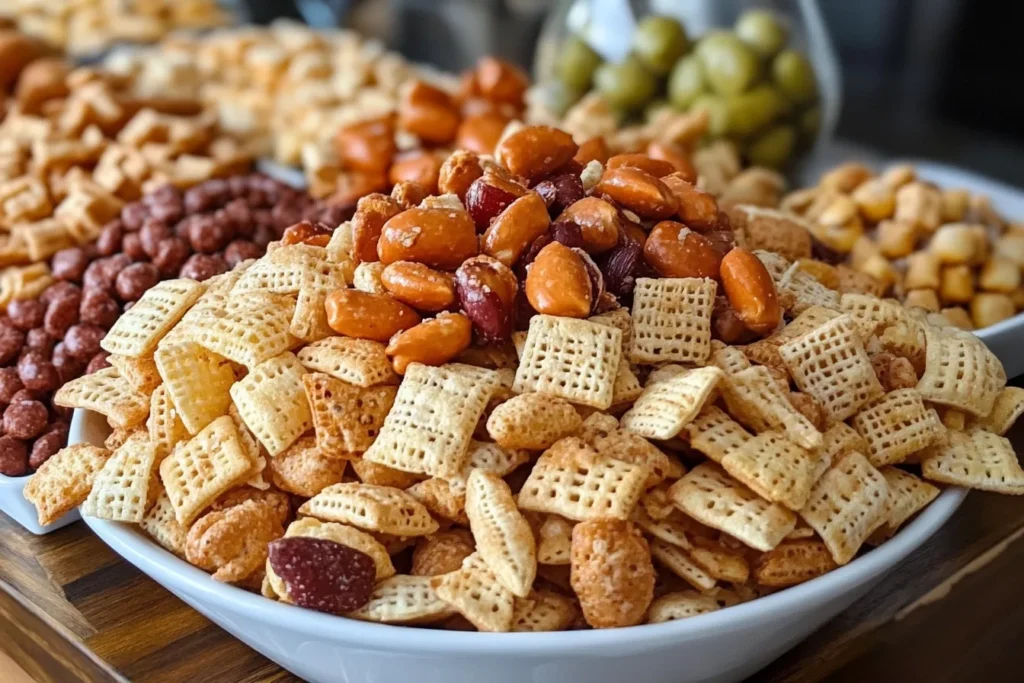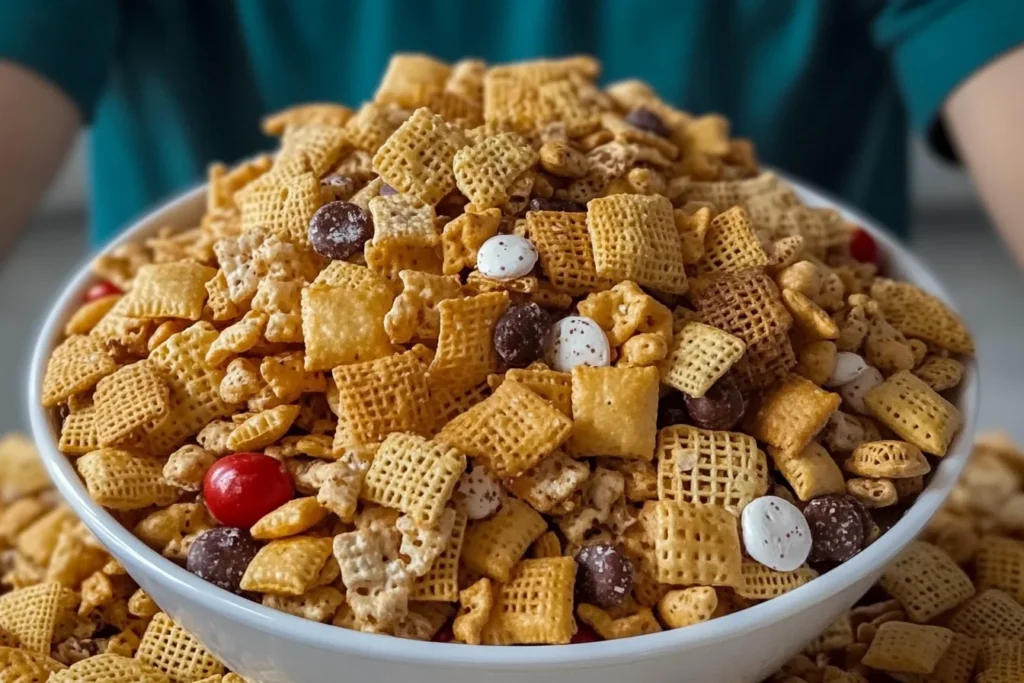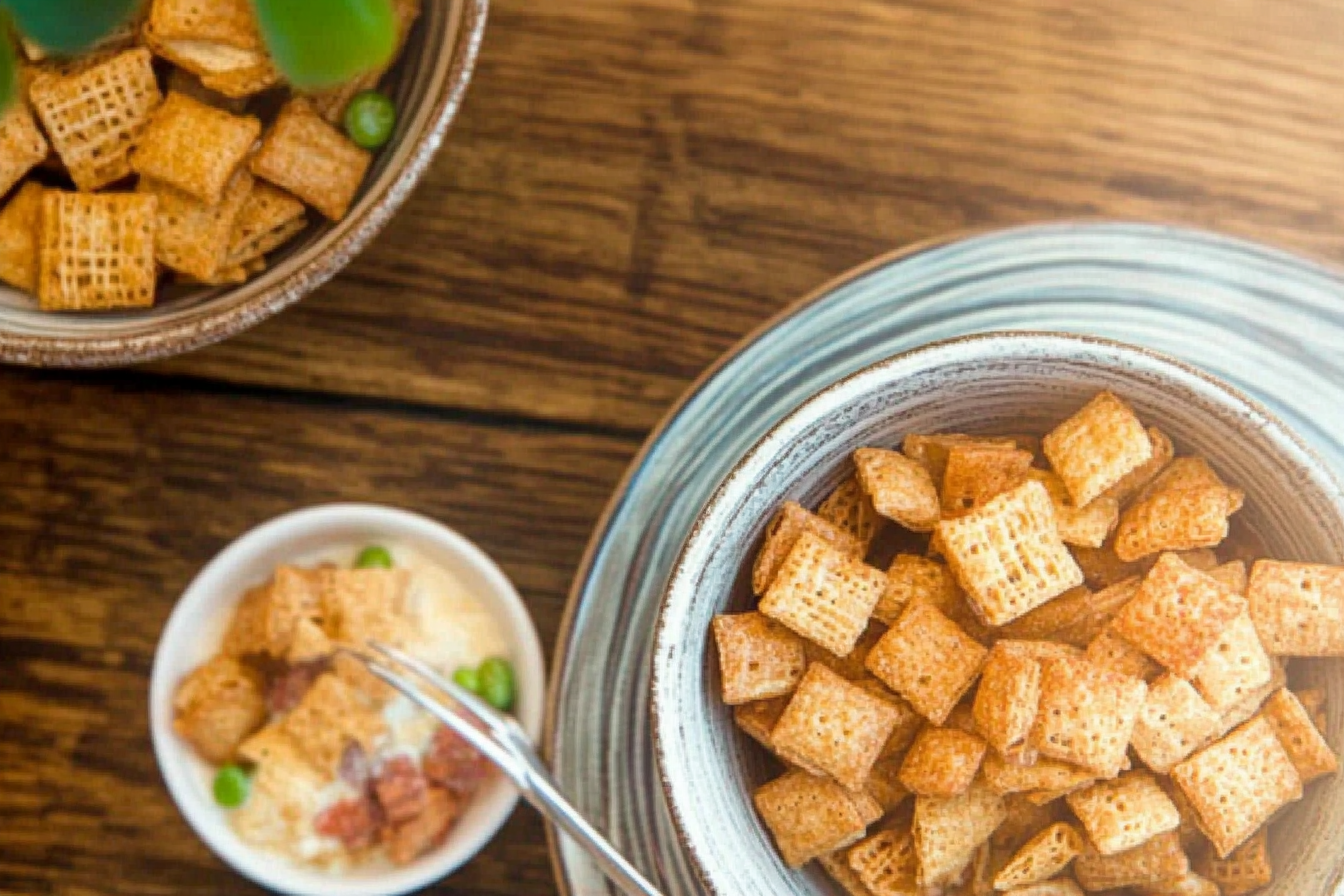Homemade Chex Mix soggy is a delightful, crunchy snack cherished by families and party-goers alike. However, achieving the perfect crispiness is not always straightforward. If you’ve ever wondered why your homemade Chex Mix ends up soggy, you’re not alone. In this guide, we’ll delve into the reasons behind this issue and how to prevent it.

Part 1: Understanding the Problem
1.1 What is Chex Mix?
Chex Mix is a savory snack blend made with cereals, pretzels, nuts, and seasonings. It’s renowned for its crispy texture and bold flavors. Traditionally, the mix is baked or microwaved after being coated with a butter-based seasoning.
Popularized as a homemade treat, Chex Mix is often a combination of both store-bought and customized ingredients. However, if prepared incorrectly, this beloved snack can turn out soggy instead of crunchy.
1.2 Common Expectations for Texture in Homemade Chex Mix
The hallmark of a great Chex Mix is its crunchy texture. Every bite should be:
- Crispy, without feeling overly dry.
- Well-seasoned, but not sticky or moist.
- Balanced in flavor and texture among the mix components.
Homemade versions often aspire to replicate or even surpass the store-bought crunch. Unfortunately, missteps in preparation, ingredients, or storage can result in a soggy texture that ruins the experience.
1.3 What Causes Sogginess in Snacks Like Chex Mix?
There are several culprits behind soggy Chex Mix:
- Excess moisture: Ingredients with high moisture content (or too much liquid seasoning) can prevent proper crisping.
- Improper cooking: Insufficient baking or uneven heat distribution leads to soft spots.
- Humidity: Environmental moisture can seep into improperly stored Chex Mix.
- Overcrowding: Packing the pan or dish too tightly prevents airflow, hindering evaporation.
Addressing these issues is key to achieving that perfect crunch.
Ingredients and Their Role
1.4 The Role of Butter in Chex Mix
Butter is the star ingredient in most Chex Mix recipes. It serves multiple purposes:
- Flavor enhancer: Butter provides a rich, savory base for the seasoning.
- Binding agent: It helps the seasoning stick evenly to each component.
- Crisping agent: When baked correctly, butter aids in developing a crunchy texture.
However, too much butter or uneven application can lead to soggy spots in your mix.
1.5 Ingredient Moisture Levels and Their Impact on Texture
Moisture is the enemy of crispiness. Here’s how it plays a role in sogginess:
- High-moisture ingredients like certain nuts or fresh pretzels can release water during cooking.
- Adding too much liquid seasoning saturates the cereal pieces, making it harder for them to crisp up.
- Substituting ingredients (e.g., using oil instead of butter) without adjusting ratios can upset the delicate balance of wet and dry elements.
Cooking Methods
1.6 Baking vs. Microwave Preparation: How Methods Affect Crispiness
Both methods have pros and cons:
- Baking: Allows for even heat distribution, promoting crispiness. However, improper oven calibration or skipping preheating can result in uneven cooking.
- Microwaving: Faster but less consistent. This method often leads to uneven drying, with some pieces soggy while others overcooked.
For the best results, baking is the preferred method for achieving consistent crispiness.
1.7 The Importance of Evenly Coating Ingredients
Uneven coating is a common mistake in homemade Chex Mix. Here’s why it matters:
- Proper seasoning distribution ensures every bite has balanced flavor.
- Ingredients with uneven coating may either dry out or retain moisture during cooking.
To avoid this, always toss the mix thoroughly after adding liquid seasoning.
1.8 Overcrowding the Pan or Dish: A Recipe for Sogginess
When making Chex Mix, it’s crucial to provide enough space for air circulation. Overcrowding:
- Prevents heat from reaching all ingredients evenly.
- Traps steam, causing the mix to stay moist.
Spread the mix in a single layer on a baking sheet for best results.

Storage Considerations
1.9 Storing Chex Mix: Moisture Control and Airtight Containers
Once your Chex Mix is perfectly crisp, proper storage is essential. Follow these tips:
- Airtight containers: Prevent external moisture from seeping in.
- Cool, dry place: Avoid storing Chex Mix in humid environments, which can reintroduce sogginess.
1.10 Effects of Humidity on Snack Freshness
Humidity is a hidden culprit for soggy Chex Mix. Even if prepared correctly, improper storage in humid conditions can ruin the texture. To combat this:
- Add a small packet of silica gel (like those found in snack packages) to the container to absorb moisture.
- Avoid leaving the mix out in the open air for extended periods.
Part 2: Diagnosing Issues in Homemade Chex Mix
Making homemade Chex Mix can be a labor of love, but identifying what went wrong when your mix turns soggy is just as important as preparation itself. Let’s dive deeper into diagnosing the most common issues and uncovering the solutions.
Signs of Common Problems
2.1 Signs of Overuse of Liquid Ingredients
Too much liquid in your seasoning mix is one of the primary culprits of sogginess. Here’s how you can tell if this might be your problem:
- The mix feels sticky or damp even after cooling.
- Some cereal pieces have a shiny, wet coating instead of a crisp, baked look.
- Puddles of seasoning liquid are visible at the bottom of your baking sheet or bowl.
Solution: Reduce the amount of butter or other liquids in your recipe. Instead, amp up dry seasonings like powdered garlic, onion, or paprika to maintain flavor without excess moisture.
2.2 Not Toasting Ingredients Thoroughly: A Key Mistake
Properly toasting your ingredients is critical for achieving that signature crunch. Signs you might have under-toasted include:
- Pale, unbrowned cereal pieces.
- Lack of uniform texture across your mix (e.g., some parts are crunchy, others soggy).
Solution: Extend the baking time slightly and ensure your oven is preheated. Stir the mix every 15 minutes to promote even toasting.
Ingredient Substitutions
2.3 How Changes in Ingredients Can Impact Texture
When substituting ingredients, you may unintentionally introduce excess moisture or disrupt the balance of flavors. For example:
- Replacing butter with margarine can increase water content, leading to sogginess.
- Using fresh pretzels or nuts with a high moisture content can make the mix less crispy.
Solution: Stick to dry, shelf-stable substitutes and adjust liquid ingredients accordingly. For example, if switching to a different fat like olive oil, reduce the amount slightly.
2.4 Using Pre-Made or Frozen Ingredients: Pros and Cons
While convenient, pre-made or frozen ingredients come with their own set of challenges:
- Frozen nuts or pretzels may release water as they thaw, softening the mix.
- Pre-seasoned ingredients could have hidden moisture or grease that interferes with toasting.
Solution: If using frozen ingredients, thaw and dry them completely before adding them to the mix. For pre-made snacks, check their texture and moisture content before mixing.
Seasoning Mix Problems
2.5 Too Much Liquid Seasoning: Common Pitfalls
Liquid seasoning is essential for flavor, but too much can overwhelm the dry ingredients and lead to sogginess. Warning signs include:
- Visible clumps of seasoning pooling on the ingredients.
- A gummy or sticky residue on cereal pieces.
Solution: Gradually add seasoning in smaller increments, tossing thoroughly between additions to ensure even coating without oversaturation.
2.6 Avoiding Clumps in Seasoning: Distribution Techniques
Uneven seasoning not only affects texture but can also create soggy pockets within your mix. Here’s how to avoid clumping:
- Use a whisk to mix your liquid seasoning thoroughly before pouring.
- Drizzle the seasoning over the mix slowly while tossing continuously.
- Spread the mix out on a large, flat surface to coat evenly.
Pro Tip: For a more even distribution, consider using a spray bottle to lightly mist your liquid seasoning.
Cooking Tools and Their Impact
2.7 Best Pans for Achieving Crispy Results
The type of pan you use can significantly affect the outcome of your Chex Mix. For the best results:
- Avoid glass dishes, as they retain moisture and heat unevenly.
- Opt for metal baking sheets, which allow for faster and more consistent heat distribution.
2.8 Using Parchment Paper or Non-Stick Spray Correctly
While these tools can help prevent sticking, improper use may lead to moisture retention:
- Parchment paper: Use sparingly, as it can trap steam beneath the mix.
- Non-stick spray: Apply only a thin layer to avoid creating a greasy surface.
Timing and Heat Levels
2.9 How Overcooking or Undercooking Leads to Texture Problems
Cooking time and temperature are delicate balances. Here’s what to watch for:
- Undercooking: Leaves ingredients pale, soft, and unevenly toasted.
- Overcooking: Burns delicate components like cereal, leading to bitterness.
Solution: Use a moderate temperature (around 250°F to 275°F) and stir frequently for even results.
2.10 Adjusting Cooking Time for Batch Size
Cooking times should be adjusted based on the size of your batch. Signs you’ve miscalculated include:
- Larger batches taking longer to crisp due to overcrowding.
- Smaller batches drying out or burning too quickly.
Solution: Spread large batches across multiple pans and rotate them during cooking to ensure even heat exposure.
Part 3: Preventing Soggy Chex Mix in the Future

After diagnosing the causes of soggy Chex Mix, it’s time to focus on proactive strategies to ensure that your snack turns out perfectly crispy every time. From optimizing preparation techniques to innovative tools, this part covers everything you need to know.
Preheating and Ingredient Preparation
3.1 Preheating the Oven or Microwave: A Necessary Step
One of the simplest yet most overlooked steps in ensuring a crunchy Chex Mix is preheating. Here’s why it’s crucial:
- Consistent heat: Preheating ensures the mix cooks evenly from the start.
- Prevents sogginess: Ingredients begin crisping immediately, reducing the time for moisture to linger.
Pro Tip: Preheat the oven to 250°F or microwave on high for 1–2 minutes before adding your mix. For the oven, allow at least 10 minutes for thorough preheating.
3.2 How to Achieve the Perfect Balance of Liquid and Dry Ingredients
Finding the right ratio of wet to dry ingredients is key to avoiding sogginess. Follow these tips:
- Use just enough liquid seasoning to coat all ingredients lightly—avoid excess pooling at the bottom.
- Adjust recipes with higher-fat substitutions (like oil instead of butter) by decreasing the liquid slightly.
- Combine your seasoning with dry spices to reduce the overall liquid content while maintaining flavor.
Improving Techniques
3.3 Tossing the Mix Regularly During Cooking
Even distribution is vital for uniform crispiness. Regularly tossing your Chex Mix during cooking helps:
- Prevent hot spots: Ingredients closest to the heat source won’t over-toast while others remain undercooked.
- Redistribute moisture: Ensures any residual liquid evaporates evenly.
How Often to Toss: Stir every 10–15 minutes during baking or every 1–2 minutes when microwaving.
3.4 Layering Ingredients for Uniform Heat Exposure
Layering ingredients can significantly improve the texture of your Chex Mix:
- Spread components in a single layer on the baking sheet to ensure even exposure to heat.
- For larger batches, bake in multiple trays instead of piling everything together.
If using the microwave, opt for wide, shallow dishes to maximize surface area.
Advanced Tips for Crispier Results
3.5 Adding a Cooling Step After Cooking to Maintain Texture
Skipping the cooling step is a common mistake. Here’s how proper cooling ensures crispiness:
- Prevents steaming: Ingredients need airflow to release residual moisture.
- Locks in texture: Cooling on a wire rack or parchment-lined tray solidifies the crunch.
Pro Tip: Spread the mix on a cool surface immediately after cooking and avoid sealing it in containers while warm.
3.6 Using a Dehydrator for Professional-Level Crispness
If you’re serious about achieving the ultimate crunch, consider using a food dehydrator. Here’s why it works:
- Low, steady heat: Dehydrators eliminate residual moisture without overcooking.
- Even drying: Air circulates evenly, ensuring every piece is crispy.
How to Use: After initial baking or microwaving, transfer the mix to the dehydrator and set it to 120°F for 1–2 hours.
Innovative Recipes and Tweaks
3.7 Alternatives to Butter for a Healthier, Crispier Snack
Butter is a classic choice, but there are healthier substitutes that can also improve crispiness:
- Coconut oil: Adds a subtle sweetness and crisping properties.
- Avocado oil: High smoke point and neutral flavor make it ideal for baking.
- Ghee: Provides butter’s rich flavor with less water content, reducing the risk of sogginess.
Pro Tip: Combine these oils with dry seasoning blends to create a light, crispy coating.
3.8 Infusing Dry Spices for Intense Flavor Without Sogginess
Dry spices are your best friend for adding bold flavor without excess moisture. Here’s how to make the most of them:
- Toast spices like garlic powder, smoked paprika, or cumin before adding them to your mix for a deeper flavor profile.
- Use spice blends instead of liquid marinades to enhance taste without compromising texture.
Storage Best Practices
3.9 Keeping Chex Mix Fresh for Longer: Tips and Tricks
Proper storage is crucial for maintaining crispiness. Follow these tips:
- Use airtight containers: Prevents moisture from seeping in.
- Cool completely before storing: Warm ingredients can create condensation inside containers, softening the mix.
- Store with moisture absorbers: Place a silica gel packet or a piece of dry rice in the container to absorb excess humidity.
3.10 Avoiding Environmental Factors That Cause Sogginess
Environmental factors like humidity can ruin even the best-made Chex Mix. Here’s how to combat them:
- Avoid preparing or storing your mix in high-humidity areas like kitchens during cooking or rainy weather.
- Refrigerate the mix in airtight containers if you live in a particularly humid climate.
Bonus Tip: If your mix does go soggy, a quick bake in the oven at 250°F for 10–15 minutes can help restore its crunch.
More FAQs About Chex Mix
- Can I fix soggy Chex Mix?
Yes! Re-bake or microwave it to remove excess moisture and restore crispiness. - What is the best fat for crispy Chex Mix?
Butter and ghee work well, but coconut or avocado oil are great healthier alternatives. - How long can I store Chex Mix?
Stored properly, it lasts up to 2 weeks in an airtight container. - Why does my Chex Mix burn before it crisps?
Likely due to a high oven temperature—stick to 250°F and stir regularly. - Can I make Chex Mix without butter?
Yes! Use oils or even spray-on alternatives for a lower-fat version. - Is it better to use fresh or pre-packaged nuts?
Pre-packaged nuts are drier and better suited for Chex Mix to avoid excess moisture. - How do I stop seasoning from clumping?
Toss ingredients thoroughly and drizzle liquid seasoning in small amounts. - Can I freeze Chex Mix?
Freezing is not recommended, as it can alter texture upon thawing. - What’s the ideal serving temperature for Chex Mix?
Room temperature is best for preserving its crunch. - Why does my microwave Chex Mix taste uneven?
Uneven cooking—stir it frequently during the process for balanced seasoning and texture.

